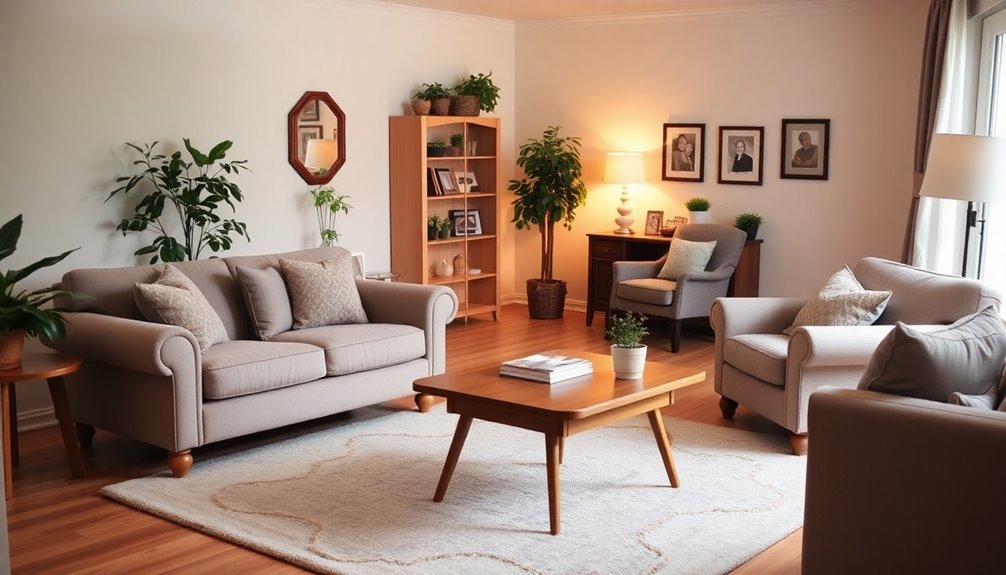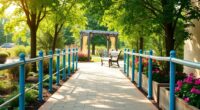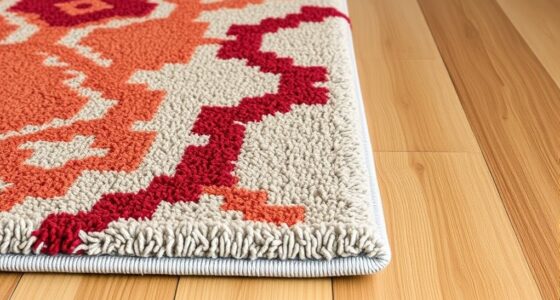To optimize your home with senior-friendly furniture setups, you’ll want to focus on comfort, accessibility, and safety. Choose adjustable, ergonomic pieces that support mobility, like sofas with lower heights. Incorporate sturdy, lightweight furniture for easy rearrangement, and guarantee clear pathways to reduce trip hazards. Install grab bars in key areas and prioritize well-lit spaces. These updates not only enhance quality of life but create a more inviting atmosphere. You’ll discover even more helpful tips ahead! Additionally, consider using essential furniture for senior comfort, such as recliners that provide optimal lumbar support and dining chairs with armrests for easier sitting and standing. Soft textiles and warm colors can also contribute to a cozy environment, making the home feel more welcoming. By thoughtfully selecting furniture and layout, you can foster independence while ensuring that your living space meets the unique needs of seniors.
Key Takeaways
- Select furniture with adjustable heights to accommodate different mobility needs and ensure comfort for seniors.
- Incorporate ergonomic designs with lumbar support to promote better posture and reduce discomfort during prolonged sitting.
- Use lightweight materials for easy rearrangement, allowing for flexible layouts that enhance accessibility throughout the home.
- Ensure all pathways are clear and clutter-free to facilitate safe navigation for seniors and those with mobility aids.
- Include supportive elements like grab bars in key areas, enhancing safety and independence in everyday activities.
Understanding the Principles of Universal Design for Home Modifications

As you consider making your home more senior-friendly, it's vital to understand the principles of universal design. This approach focuses on creating spaces that guarantee accessibility for everyone, regardless of age or ability.
By incorporating universal design in your home modifications, you enhance safety and comfort for aging residents facing mobility challenges. Key elements like ramps, non-slip flooring, and lever-style door handles create an environment that supports aging in place. These modifications not only reduce barriers and accident risks but also improve the overall functionality and aesthetic appeal of your home. Embracing universal design principles means prioritizing inclusivity, making certain that your living space remains welcoming and functional for all individuals, enhancing their quality of life. Additionally, utilizing home improvement resources can provide further guidance on effective modifications tailored for senior needs.
Optimizing Home Furniture for Safety and Accessibility

To create a safe and accessible living space for seniors, it's essential to choose furniture that meets their specific needs. Prioritizing safety and comfort not only enhances their quality of life but also promotes independence. Here are some essential tips:
- Opt for adjustable furniture, like height-adjustable chairs and beds, for ideal comfort and accessibility.
- Install non-skid flooring to reduce the risk of slips in high-traffic areas, as maintaining effective ventilation can also help reduce moisture that may lead to slippery surfaces. Additionally, ensuring consistent daily routines can help reduce anxiety and promote stability in their environment.
- Choose ergonomically designed furniture that offers lumbar support for better posture.
- Implement easy-to-reach storage solutions, such as pull-out shelves, to minimize mobility challenges.
Incorporating home and heritage into the design can also foster a sense of belonging and well-being for seniors.
Key Areas to Enhance for Elder-Friendly Living

Creating a home that accommodates seniors involves focusing on key areas that can greatly enhance their safety and comfort.
Start with the bathroom by installing grab bars and non-slip mats to reduce hazards. Additionally, consider the importance of monitoring financial accounts to help seniors maintain their independence without financial worries. It is also crucial to understand the legal grounds for divorce in case seniors face relationship changes that could impact their living situation.
In the bedroom, use lower bed heights and optimize lighting for better visibility at night.
The kitchen should have clear walkways and non-skid flooring, with frequently used items within easy reach.
Living areas benefit from supportive furniture that offers good lumbar support while maintaining clutter-free spaces to enhance accessibility.
Don't forget to install emergency alert systems throughout the home, providing immediate assistance when needed. Additionally, maintaining a clean and organized environment helps reduce stress and improves overall well-being for seniors.
Creating a Supportive Environment: Tips for Selecting the Right Furniture

When selecting furniture for seniors, you should prioritize functionality and safety above all. Choose sturdy pieces that support mobility, like chairs with armrests, and guarantee there's a variety of comfortable seating options. A well-thought-out layout with clear pathways will make traversing the space easier and safer. Additionally, consider incorporating consistent routines in the environment to enhance comfort and familiarity for seniors. It is also important to ensure that all furniture complies with safety standards to prevent accidents and provide a secure living space. Including large indoor plants can also improve air quality and contribute to a calming atmosphere.
Prioritize Functionality and Safety
Ensuring safety and functionality in furniture setups is essential for seniors, especially since they often face mobility challenges.
Prioritizing these aspects reduces the risk of accidents and fosters a comfortable home. Here are some tips to reflect on:
- Choose stable, sturdy furniture for proper support and stability.
- Select height-adjustable chairs and beds to accommodate varying mobility needs.
- Opt for ergonomic designs to promote better posture and balance.
- Keep pathways wide and free of clutter to facilitate easy navigation. Additionally, consider incorporating energy-efficient systems to maintain a comfortable environment year-round.
Incorporating grab bars near chairs and beds enhances independence, while non-slip mats can minimize slips. Additionally, consider using electric heated mattress pads to maintain warmth and comfort during colder months. Regular preventive care can also ensure that any associated appliances, like heating pads, function efficiently and safely.
Ensure Comfortable Seating Options
To foster a supportive environment for seniors, comfortable seating options play an essential role in enhancing their daily living experience.
Choose chairs with proper lumbar support and armrests to reduce strain on their back and arms, especially during long periods of sitting. Height-adjustable furniture, like chairs and beds, can accommodate various mobility needs, making it easier for seniors to get in and out of their seats. Additionally, investing in home security systems can provide peace of mind for both seniors and their families. Incorporating smart home devices can further enhance the convenience and safety of their living environment.
Opt for lightweight materials for easy rearrangement, creating a navigable living space. Additionally, prioritize furniture with non-slip surfaces to enhance safety and prevent accidental sliding.
Also, select pieces with rounded edges and sturdy construction to minimize the risk of injuries, ensuring lasting comfort and support for your loved ones. Incorporating washable pet blankets can help contain any pet hair, maintaining a clean and comfortable environment for seniors.
Optimize Lighting for Visibility

Bright lighting solutions are essential for keeping your space safe and accessible.
By incorporating task lighting in areas like reading nooks or kitchens, you can reduce eye strain and improve usability.
Let's explore how these adjustments can enhance visibility throughout your home.
Bright Lighting Solutions
When it comes to creating a safe home environment for seniors, proper lighting plays an essential role in preventing accidents. Bright lighting solutions can greatly enhance safety and guarantee well-lit spaces throughout your home.
Consider these tips:
- Install brighter bulbs in hallways, staircases, and entrances for improved visibility.
- Utilize motion-sensor lights to automatically illuminate paths at night, providing security and convenience.
- Maximize natural light during the day by keeping windows clear and using light-colored curtains.
- Incorporate task lighting in kitchens and reading nooks to support activities that require focused light.
Task Lighting Importance
Proper task lighting is essential for seniors, as it greatly enhances visibility in areas where activities like reading, cooking, or pursuing hobbies take place. Using adjustable lighting, like desk lamps or under-cabinet lights, allows you to direct light precisely where it's needed, reducing shadows and improving clarity.
| Task Lighting Type | Benefits | Features |
|---|---|---|
| Desk Lamps | Enhance visibility | Adjustable height |
| Under-Cabinet Lights | Safety for seniors | Energy-efficient LED bulbs |
| Floor Lamps | Reduce glare | Dimmable options |
| Wall Sconces | Custom brightness | Stylish and functional |
| Clip-On Lights | Versatile placement | Easy to move |
Incorporating these elements will create a safer environment tailored to your comfort.
Install Handrails and Grab Bars

To enhance safety in your home, installing handrails and grab bars is essential. These features provide necessary support and stability, helping to reduce the risk of falls, especially in areas like bathrooms.
Here are some key tips for effective installation:
- Securely install handrails in hallways and staircases for added stability.
- Position grab bars near toilets, showers, and bathtubs at a height of 33 to 36 inches.
- Verify handrails have a comfortable grip, around 1.25 to 2 inches in diameter.
- Regularly inspect all installations for wear or loosening to maintain safety.
Enhancing Mobility Throughout the Home

As you consider ways to enhance mobility throughout your home, small changes can make a significant difference in your daily life.
Upgrading to lever-style door handles promotes ease of use, allowing for easier operation with less strength.
Verify your flooring is slip-resistant to minimize trip hazards, especially in high-traffic areas.
Reducing thresholds between rooms helps prevent tripping, creating smoother shifts.
Incorporating adjustable furniture, like height-adjustable chairs and beds, enhances comfort and accessibility for those with limited mobility.
Finally, maintain clear pathways and organized layouts, free of clutter and loose cords, to promote safe navigation.
These adjustments collectively improve mobility, making your home a more welcoming and secure environment.
Adapting Bathrooms for Increased Safety for the Elderly

While adapting your bathroom for increased safety, it's important to focus on features that greatly reduce the risk of falls.
Here are some key upgrades to take into account for a safe and accessible environment:
- Install Grab Bars near the toilet and inside the shower for added stability.
- Use non-slip surfaces like mats and tiles to combat moisture-related slips.
- Opt for walk-in showers with seating and handheld showerheads for safer bathing options.
- Verify proper lighting with motion-sensor lights to enhance visibility, especially at night.
Incorporating lever-style handles on faucets makes daily routines easier for those with limited hand strength.
These improvements promote senior living by creating a safer and more user-friendly bathroom experience.
Designing Elder-Friendly Staircases

When designing elder-friendly staircases, you'll want to focus on handrail installation and lighting solutions.
Installing sturdy handrails on both sides of the stairs can provide essential support, while well-placed lighting helps guarantee visibility.
Handrail Installation Guidelines
To guarantee seniors can navigate staircases safely, it's crucial to install handrails that provide reliable support.
Here are some key guidelines to guarantee maximum staircase safety:
- Install handrails on both sides of the staircase for ideal support and stability.
- Choose a grip diameter between 1.25 to 2 inches for a comfortable grip, accommodating various hand strengths.
- Confirm handrails are securely anchored to the wall and can bear at least 250 pounds to effectively prevent falls.
- Extend handrails at least 12 inches beyond the top and bottom steps to facilitate safe changes.
Staircase Lighting Solutions
Creating a well-lit staircase is essential for ensuring seniors can navigate safely and confidently. Adequate lighting enhances stairway safety, so consider using overhead lights that illuminate the entire staircase evenly.
Installing motion-sensor lights can boost visibility by activating as someone approaches, keeping the stairs well-lit at all times. To further improve safety, use contrasting colors for handrails and stair edges, helping older adults identify their path.
Additionally, incorporating LED strip lights along the edges of each step provides extra illumination, considerably reducing slips and falls.
Regularly evaluate and upgrade your lighting to meet the needs of aging residents, as declining vision may require brighter, more effective solutions for optimizing lighting throughout your home.
Creating Safe and Accessible Entryways for the Elderly

A well-designed entryway can make a world of difference for elderly individuals, enhancing both safety and ease of access.
To create safe and accessible entryways, consider the following elements:
- Bright, glare-free lighting to improve visibility
- Ramps instead of stairs to accommodate mobility needs
- Convenient landing places like tables or benches for secure item placement
- Non-slip mats to reduce slips and falls
These furniture setups not only enhance comfort but also contribute to a supportive home environment.
Frequently Asked Questions
How to Make Your Home More Senior Friendly?
To make your home more senior-friendly, start by incorporating adjustable furniture that suits different mobility needs.
Choose sturdy pieces that offer proper support and facilitate easy movement.
Clear pathways by removing excess furniture to allow for walkers or wheelchairs.
Install non-skid flooring and secure area rugs to prevent slipping.
Finally, organize storage so frequently used items are within reach, minimizing the need for bending or stretching.
These changes enhance safety and comfort.
How to Design a House for Seniors?
Designing a house for seniors is like creating a fortress of comfort and safety!
You'll want to incorporate adjustable furniture to adapt to their unique needs. Non-skid flooring and secure rugs are a must to eliminate tripping hazards.
Make certain pathways are clear and at least 36 inches wide for easy movement. Don't forget grab bars in essential areas and bright, motion-sensor lighting to illuminate dark corners.
With these, you'll create a haven for seniors!
What Is the Most Desirable Home Design for Aging in Place?
The most desirable home design for aging in place focuses on creating open floor plans that minimize obstacles and guarantee clear pathways for easier mobility.
You should consider incorporating adjustable furniture for comfort and accessibility. Non-slip flooring is essential, and arranging furniture to maintain spacious, clutter-free areas can greatly reduce fall risks.
Finally, having essential spaces like the bedroom and bathroom on the main floor enhances safety and convenience, making daily living easier.
What Do Seniors Want in a Home?
Seniors want a home that prioritizes safety and accessibility.
You'll find features like non-slip flooring and grab bars essential for preventing accidents. They also prefer functional furniture, such as height-adjustable chairs and beds, to accommodate varying mobility needs.
Open layouts with clear pathways help you navigate easily, while organized, reachable storage minimizes clutter.
Most importantly, personalizing your space with cherished items fosters a sense of belonging and emotional well-being.
Conclusion
Incorporating these senior-friendly furniture setups can truly make a world of difference in your home. By prioritizing safety, accessibility, and comfort, you're not just creating a living space, you're building a sanctuary that fosters independence. Remember, it's the little things that count—like a well-placed chair or brighter lighting. So, take these tips to heart, and you'll be paving the way for a more inviting and supportive environment for you or your loved ones.









